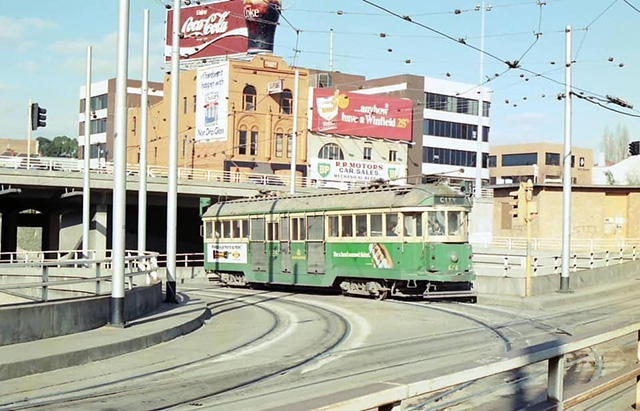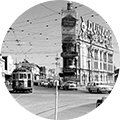When I first came to live in Melbourne in the mid 1980s, St Kilda Junction was one of the first places I used to orientate myself around the city. At this time on the corner of St Kilda Road and Wellington Streets the Junction was dominated by a large 3D glass of Coca Cola, which was later, replaced by a similar size glass of Swan Beer. A reoccurring and current theme of St Kilda Junction was its role as host for advertising billboards and paraphernalia.1

W Class Tram at St Kilda Junction ca 1980s
Click here for a video clip on YouTube that shows the Junction how I remember it when I first came to Melbourne; including the big Coco Cola Glass in the background.
I living in Elsternwick at the time and the Junction was one of the prominent transit points on my way home from work in the Central Business District. Longing to get home, it was a midway point after a tiring day; it was a relief that I was half way home. I would wearily look through the window of the tram at the dreary Junction and the silent passengers waiting patiently for their own tram and journey home. This was before mobile phones and 3G applications so people just stared blankly into space or consulted their newspaper as they waited. At this time the Junction had little meaning to me beyond being a transitory signpost. Many years later when I came to live in St Kilda, the Junction became a more familiar place but still a place to wait for a bus or tram or be delayed at the traffic lights while trying to get somewhere else.
The Junction is located approximately 6 kilometres south of the Central Business District. It is a transport intersection linking the heart of Melbourne to the south-eastern suburbs and is a series of tangled roads, fly-overs, tunnels and walkways.
Google Map of St Kilda Junction, Melbourne, Australia
At its centre is a triangular space with basic landscaping of shrubs and trees, interconnecting tramlines, overhead cables and recently extensive street art. From the Junction you can go west to St Kilda, continue south to the bayside and southern suburbs or turn east into Dandenong Road and travel to the south-eastern suburbs. Teams of cars, trucks, buses hurtle through the Junction in an endless stream and trams rattle by at regular intervals. You can choose to cross the road if the timing of the traffic lights is right or you can make your way through the maze of pedestrian walkways and underpasses. These are dark, bleak and sometimes smell of urine and paved with litter. Waiting for a tram or bus, the Junction is windy and cold in winter and dry, dusty and hot in summer. The landscaping is tired but the trees and scrubs seem to be trying to reclaim their Junction. Passengers in formal suits and ties or neatly pressed tops and skirts play with their mobile phones or tablets as they anticipate their ride to the city, a cheerful couple of backpackers wait hand in hand for the number 16 tram to go to St Kilda beach and still others loiter around ready to head to their destination. A regular identity of the Junction wonders past, looking for cigarette butts and checking the garbage bins. Everyone one ignores him despite the smell, he is not there and neither are they, they are already somewhere else. A tram arrives and people alight and then quickly scuttle away in all directions, still others move onto the tram and begin their journey. This is the Junction to me, a forlorn place, isolating, tired and unkempt but something that has been a regular in my life as it has for so many other people.
This brief history explores St Kilda Junction from its early beginnings to the present. By looking at the history of the Junction I hope to move beyond my personal perceptions and consider larger forces within the urban environment that have affected the Junction and driven change. This may also help inform future decision-making about the Junction and the wider urban landscape and environment. The Junction’s story has much to tell us about our experience and interaction with that urban environment and landscape.2
There are two major histories have been written about St Kilda which make multiple references to the Junction. These are John Butler Cooper’s The History of St Kilda Volumes 1 & 2 From Its First Settlement To A City: 1840 to 1930 and Anne Longmire’s The History of St Kilda: Volume 3 The Show Goes On: 1930 to July 1983. These works are major references for the Junction’s history as they draw upon multiple original sources.
Cooper’s work was commissioned by the St Kilda City Council and is largely a history of St Kilda through the prism of the Council. It has a great amount of detail but limited wider analysis of the social, political, economic or cultural implications. It does however, provide some interesting references concerning the development and changes to St Kilda Junction between 1840 and 1930. Anne Longmire’s work also commissioned by the St Kilda City Council shows the hand of the modern professional historian as she discusses many issues concerning the changing nature of St Kilda.
Longmire’s references to St Kilda Junction are in a broader socio-economic and cultural context and provide some discussion of the redevelopment of the Junction during the late 1960s and early 1970s. Newspaper articles (e.g. The Age and The Argus) have been used in this history because they highlight contemporary issues and provide valuable insight into people’s experience of the Junction at different periods of its life. Government publications and reports such as Melbourne Metropolitan Planning Commission Reports of 1925 and 1954 and have been utilised for there illustration of associated management and development issues. Other sources that provide insight into broader social, political and economic forces that have impacted on the Junction have also been employed. These included Graeme Davison’s Car Wars: How the car won our hearts and conquered our cities and Graeme Turnbull’s, The development and retention of Melbourne’s trams and the influence of Sir Robert Risson.
These sources have been used in this history to identify some of the Junction's major historical themes and form the basis of this brief summary.
Footnotes



